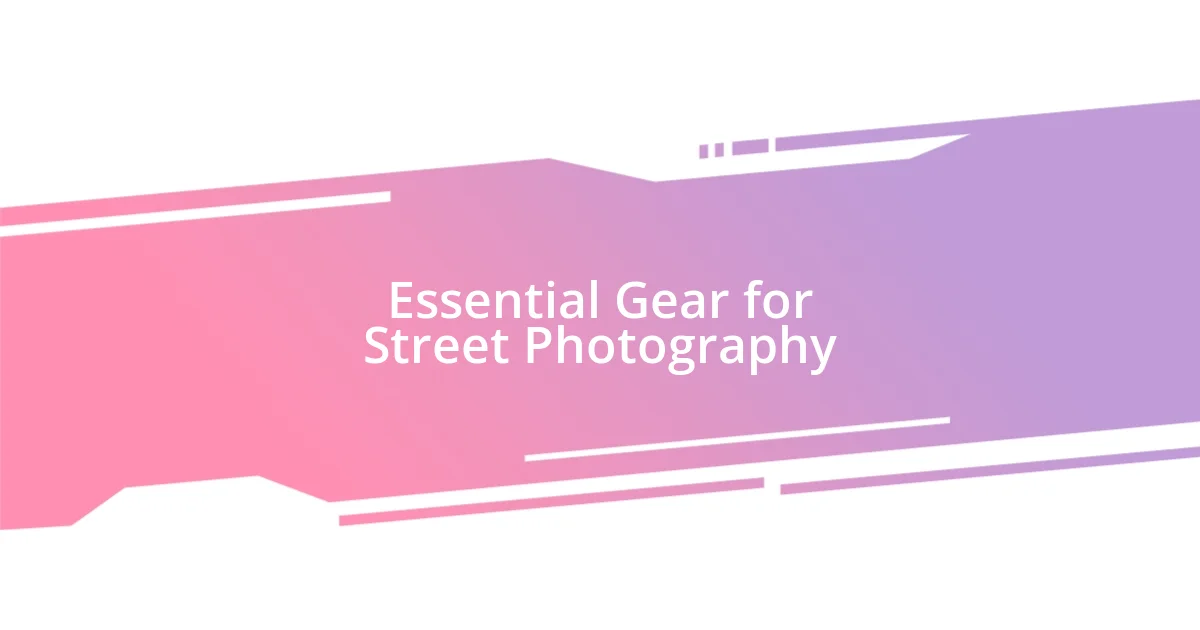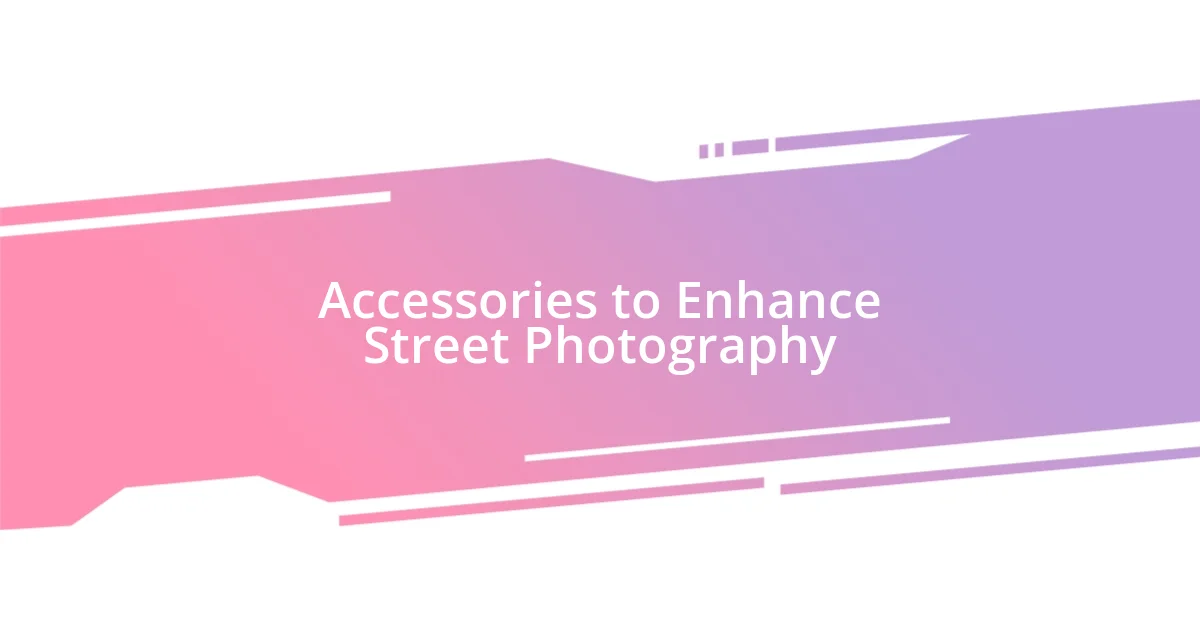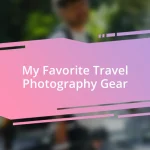Key takeaways:
- A lightweight mirrorless camera with a prime lens (35mm or 50mm) is essential for capturing candid scenes in street photography.
- Investing in a reliable camera bag enhances quick access to gear and supports spontaneous shooting experiences.
- Regular maintenance and gear reviews, including checking settings and cleaning equipment, ensure optimal performance and avoid missing critical moments.

Essential Gear for Street Photography
When it comes to street photography, having the right camera is vital. I’ve spent countless hours experimenting with different brands and models, and I always come back to a lightweight mirrorless setup. It allows me to move swiftly through crowded streets, capturing candid moments without drawing too much attention. Have you ever noticed how heavy gear can make you feel like an outsider? A compact camera empowers you to blend in seamlessly with your surroundings.
Lenses also play a crucial role in my street photography adventures. I often rely on a prime lens, especially a 35mm or 50mm, which gives me that natural perspective without distorting reality. I remember one day, the light was just right, and I caught a fleeting glimpse of an elderly man sharing a laugh with a child. I didn’t want to compromise that moment by using a zoom lens that would just take away from the intimacy. Isn’t it amazing how the right lens can turn an ordinary scene into a captivating story?
Lastly, a reliable camera bag is something I can’t skimp on. I prefer a messenger-style bag that not only protects my gear but is also easy to access while I’m on the move. I recall a moment when I needed to switch lenses quickly as I spotted an unpredictable street performer. The ease of that bag allowed me to pivot and shoot without missing a beat. What about you? Do you have a go-to bag that supports your spontaneous nature?

Camera Types for Street Photography
When selecting the right camera type for street photography, I find that both compact and mirrorless cameras offer distinct advantages. Compact cameras are lightweight and discreet, making it easier to capture candid moments without drawing attention. On a recent outing, I carried a compact camera and felt like I was invisible, allowing me to photograph a bustling market scene in all its raw beauty. Have you ever experienced that freedom to explore without feeling burdened by your gear?
Mirrorless cameras, on the other hand, provide excellent image quality and performance. They often feature faster autofocus and better low-light capabilities, making them ideal for unpredictable street environments. I recall an evening where the sunset bathed the city streets in warm tones. The mirrorless camera I used helped me seize that fleeting magic as silhouettes danced against the fading light. Isn’t it exciting how the right technology can help you capture the extraordinary in everyday life?
Here’s a quick comparison to help clarify the differences:
| Camera Type | Pros | Cons |
|---|---|---|
| Compact | Lightweight, easy to carry, discreet | Limited manual control, smaller sensors |
| Mirrorless | High image quality, fast autofocus, good low-light performance | Bigger than compacts, battery life can be shorter |

Lenses for Street Photography
Lenses are the heart of my street photography toolkit. I often gravitate towards a 28mm or 35mm prime lens due to their versatility and compact size. These lenses provide a perfect balance between capturing close-ups while still embracing the wider scene, allowing me to tell a more complete narrative. Recently, while wandering through a vibrant festival, I captured an intimate moment of a street musician lost in his performance amidst a crowd. The simplicity of a prime lens let me get closer without intruding on his space. It’s moments like these that remind me just how powerful a good lens can be in capturing the essence of a fleeting scene.
- 35mm Prime Lens: Excellent for street photography, allowing for a natural field of view.
- 50mm Prime Lens: Great for low-light situations and portraits, offering beautiful background blur.
- Wide-Angle Lenses (24mm or wider): Perfect for capturing larger scenes or environmental portraits, emphasizing context.
- Compact Zoom Lenses (24-70mm): Flexible and great for quick shifts in subject distance without switching lenses.
- Telephoto Lenses (70mm or longer): Useful for capturing candid moments from a distance, though requiring more stealth.
Choosing the right lens can sometimes feel like picking a partner for a dance—you need to be in sync with your surroundings to truly capture the magic.

Accessories to Enhance Street Photography
Accessories can significantly enhance your street photography experience, and I’ve found a few that really make a difference. Take a sturdy strap, for example. I once used a thin, flimsy strap that made me nervous about dropping my camera while navigating bustling streets. Switching to a well-padded, cross-body strap not only eased my worries but also allowed me to shoot comfortably for hours. Have you ever felt the relief of knowing your gear is secure while you immerse yourself in your surroundings?
Another accessory I swear by is a good quality UV filter. It’s not just a protection for your lens; it can also help manage glare and enhance color contrast in bright sunlight. I’ve found it invaluable during my explorations of sun-drenched urban landscapes. On one occasion, capturing the vibrant colors of street art under harsh midday sun became so much easier with that filter. Do you have a go-to accessory that transforms your shooting experience?
Lastly, a compact, lightweight tripod can be game-changing, especially for long-exposure shots or low-light conditions. I remember a chilly evening spent photographing reflections in puddles, and my little tripod gave me the stability I needed to get sharp shots while keeping my camera at a perfect height. This often-overlooked accessory helped elevate my work beyond the ordinary. Isn’t it fascinating how something so simple can sometimes unlock new creative possibilities?

Tips for Carrying Your Gear
When it comes to carrying your gear, comfort is paramount, especially on long street photography outings. I learned this the hard way during an entire day spent wandering through a bustling market. With my camera slung over my shoulder, I ended up with a sore neck and achy shoulder by noon. Switching to a well-balanced messenger bag made a world of difference, allowing me to distribute the weight evenly while being able to easily access my gear. Don’t you want to focus on capturing the moment rather than worrying about your discomfort?
Finding the right bag to fit your gear is just the beginning. I’ve found that a camera bag with customizable dividers can be a lifesaver. While trekking through the streets of a new city, I kept my prime lens in one section and a lightweight zoom in another, making it quick to switch depending on the scene unfolding before me. Have you ever missed a shot because you struggled to dig out the right lens? A thoughtful arrangement can save you precious seconds.
Lastly, always consider the weather. When I set out for an afternoon of street shooting, I sometimes forget how quickly conditions can shift. On one rainy day, I was caught without a weatherproof cover, and my heart sank as I watched raindrops bead on my camera. From that experience, I’ve learned to always pack a rain cover or a plastic bag for unexpected downpours. Isn’t it incredible how a small piece of preparation can protect your gear and your peace of mind?

Maintenance for Street Photography Equipment
Maintaining your street photography equipment is key to ensuring it performs at its best. I remember the time my camera suddenly froze during an intense shoot, and it turned out I hadn’t cleaned the contacts properly. A simple routine of checking and cleaning the lens and contacts before heading out can save you from those frustrating moments. How often do you think about the small things that can lead to big problems?
Another maintenance tip revolves around battery care. I learned the hard way that batteries don’t like extreme temperatures—especially in the frigid cold. Once, my camera shut down completely in the middle of capturing a bustling winter festival. Now, I keep my spare batteries in my pocket to maintain their warmth, ensuring I don’t miss out on spontaneous, heartwarming moments. Isn’t it comforting to know you have control over potential pitfalls?
Finally, don’t forget to inspect your gear after each outing. I can’t tell you how many times I’ve overlooked tiny bits of dust or moisture that crept in during a shoot. Once, I discovered a smudge on my lens before an important event, and I had to race against time to clean it. Setting aside just a few minutes after each adventure to check for any wear or damage can save you countless headaches later. Do you think you could make that time, knowing how it can enhance your shooting experience?

Reviewing Your Street Photography Gear
Reviewing your street photography gear is essential to ensure you’re equipped for the unexpected. I vividly remember overlooking a simple yet critical accessory—my lens hood. One afternoon, while shooting during a vibrant street festival, I found my images washed out due to glare. How often do we take the little things for granted? In my experience, a lens hood can be a game-changer, blocking stray light and enhancing image quality. It’s those small details that can elevate your work.
When it comes to choosing your camera settings, I recommend reviewing them before each outing. On one occasion, I had my camera set to a low ISO while capturing a lively scene, and the results were disappointingly grainy. Picture this: you’re in the midst of capturing the essence of a crowded market, and the last thing you want is to miss those fleeting moments by fumbling around. Always check your settings and make sure they’re tailored to the environment you’re shooting in. It’s a simple habit, but it saves you frustration and helps you seize those amazing opportunities.
Lastly, evaluating the condition of your gear shouldn’t be an afterthought. I once faced the disappointment of missing a stunning sunset shot because my lens had developed a pesky scratch. The emotional weight of that moment was heavy—it taught me to prioritize gear reviews. I now establish a ritual of inspecting my equipment before leaving home, making sure everything is in top shape. Have you ever taken a moment to fully appreciate the gear you rely on? That small pause can lead to fewer headaches and more striking captures out in the field.














